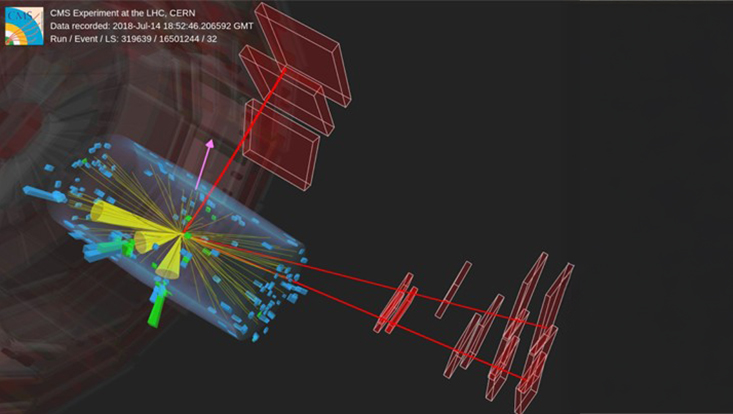Beyond the background
9 July 2025

Photo: Anna Malin Lemke
In the summer of 2023, several pulsar timing array collaborations found the first evidence for the existence of a gravitational wave background, a constant hum of gravitational waves permeating our universe. This evidence opens a new window to investigate the sources of those gravitational waves. In a recent paper, scientists from the Cluster of Excellence Quantum Universe went beyond the background and further explored the origin of the underlying gravitational waves.
Pulsar timing arrays operate by monitoring the radiation emitted by a collection of millisecond pulsars – fast spinning neutron stars that emit radio waves at extremely stable time intervals. Gravitational waves, by stretching and squeezing spacetime, can perturb the distance between these pulsars and the Earth, and induce deviations in the arrival time of the radio pulses. Some will arrive later and others earlier than expected in a predictable pattern. Hints of exactly this pattern have been found by pulsar timing arrays and with it evidence for a gravitational wave background!
It is possible that the observed gravitational waves are produced by a population of merging supermassive black hole binaries. This occurs when galaxies collide, an event that is expected to be common in cosmic history. Since each of those mergers emits gravitational waves, this could lead to such a background of unresolved gravitational wave events.
Until now, only mergers of lighter black holes have been observed, but none involving the heaviest, supermassive black holes. This also means that the knowledge of the population of these mergers of supermassive black holes is limited. There simply is no sample to observe and draw conclusions from yet.
So how can the gravitational wave background be used to learn something about this population? One option is to investigate whether the signal from an individual merger is strong enough to rise above the background. This is like distinguishing an individual voice from the background hum.
Another method is to search for anisotropies, where one investigates how the intensity of the background changes with the part of the sky we look at. Even if it is not really possible to make out a clear individual signal, there could be a merger of particularly close or massive supermassive black holes, or maybe even a region with many of these mergers very close together. This is going to appear louder than other patches of the sky. Exactly this unevenness is known as anisotropy.
In this work, the researchers looked at how the properties of the black hole population in our universe influence the chances of seeing these continuous wave sources or anisotropies. Since both methods look for very strong merger signals that are much more likely to happen for particularly heavy black hole binaries, the scientists found that the probability to observe individual mergers or anisotropies strongly depends on the population properties. These include the typical mass scale of the black holes involved or how long a merger lasts. This is good news, because it is now possible to break some degeneracies in the models. Populations that would lead to similar gravitational wave background signals have different levels of anisotropies and single source detectability. So, if either of those signals are seen anytime soon, this can be used to deduce the likely properties of the specific supermassive black hole population in our universe. On the other hand, if neither anisotropies nor single sources are detected in the coming years, other merger timescales or masses are more likely. Either way, this can be applied to learn something new about the supermassive black hole population.
Long story short: looking beyond the background is important to shine some light on the heaviest objects in the universe!
Best Paper Award
For her outstanding contributions to the paper, Anna-Malin Lemke received a Quantum Universe Best Paper Award 2024.


